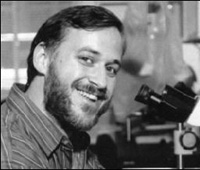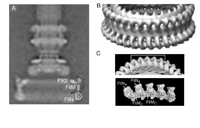David Blair
Professor of Biological Sciences
Bacterial Motility

Molecular Biology Program
Biological Chemistry Program
Education
B.A. Princeton University
Ph.D. California Institute of Technology
Research
Many species of bacteria swim by means of flagella, helical propellers driven by rotary motors in the cell membrane. The flagellar rotary motors can turn at 100,000 rpm or faster, obtaining energy from the membrane ion gradient. The motors can turn either clockwise or counterclockwise, and by controlling the direction of motor rotation in response to environmental cues, cells can move toward nutrients or other environmental factors that favor their survival. Flagellar motility has a role in the virulence of many bacterial pathogens and serves as a model for the many biological energy conversions that occur at membranes. Our goal is to understand the structure and molecular mechanism of the flagellar motor.
While more than 50 proteins altogether are needed for assembly and operation of a flagellum only a few are directly involved in rotation and switching. With our collaborators we have solved structures for most proteins that function in rotation and have arrived at a working model for the rotor. Future work will focus on using this structural framework to understand rotation and switching, and extending it to include the stator (non-rotating) pieces.
During flagellar assembly, the protein subunits that form the exterior structures are actively transported to their destinations by a specific protein-secretion apparatus at the base of the flagellum. This process is closely related to the export that occurs in the 'injectisome' that is used by many pathogenic species to deliver virulence factors into host cells. We have shown that this export process is energized by the membrane ion gradient rather than by ATP hydrolysis, and have determined the minimum set of proteins sufficient for the export to occur. Future work will be aimed at understanding the molecular mechanism of protein export by the flagellum and the injectisome.

A. Electron microscopic reconstruction of the flagellar basal body, from DeRosier
and coworkers (J. Bacteriol. 188, 7039-48). The structure is viewed from the side.
The bottom-most feature, termed the C-ring, is in the cytosol. A working hypothesis
for the locations of the FliG, FliM and FliN proteins is shown at the right of the
C-ring.
B. Detail showing rings of density at the bottom of the C-ring.
C. The appearance of the bottom of the C-ring as determined by EM, and the organization
of FliN and FliM proteins deduced from cross-linking and mutational studies.
References
- Paul K, Brunstetter D, Titen S, Blair DF (2011) A molecular mechanism of direction switching in the flagellar motor of Escherichia coli. Proc Natl Acad Sci USA, 108:17171-17176
- Paul K, Gonzalez-Benet G, Bilwes A, Crane B, Blair DF (2011) Architecture of the Flagellar Rotor. EMBO Journal, 30(14):2962-71
- Sarkar MK, Paul K, Blair D (2010) Chemotaxis signaling protein CheY binds to the rotor protein FliN to control the direction of flagellar rotation in Escherichia coli. Proc Natl Acad Sci USA, 107(20):9370-5
- Paul K, Nieto VM, Carlquist W, Blair DF, Harshey RM (2010) The c-di-GMP binding protein YcgR Controls Flagellar Motor Direction and Speed to Affect Chemotaxis by a 'Backstop-brake' Mechanism. Molecular Cell, 38(1):128-139
- Sarkar MK, Paul K, Blair DF (2010) Subunit Organization and Reversal-associated Movements in the Flagellar Switch of Escherichia coli. J Biol Chem, 285(1):675-684
- Paul K, Erhardt M, Hirano T, Blair DF, Hughes KT (2008) Energy source of flagellar type-III secretion. Nature, 581:489-492
- Lowder BJ, Duyvesteyn M, Blair DF (2005) FliG subunit arrangement in the flagellar rotor probed by targeted crosslinking. J Bacteriol, 187(16):5640-7
- Brown PN, Mathews MAA, Joss L A, Hill CP, Blair DF (2005) Crystal structure of the flagellar rotor protein FliN from Thermotoga maritima. J Bacteriol, 187:2890-2902
- Braun TF, Al-Mawsawi LQ, Kojima S, Blair DF (2004) Arrangement of core membrane segments in the MotA/MotB proton-channel complex of Escherichia coli. Biochemistry, 43:35-45
- Kojima S, Blair DF (2004) Solubilization and purification of the MotA/MotB complex of Escherichia coli. Biochemistry, 43:26-34
